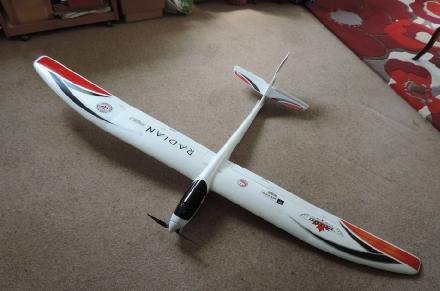|
Parkzone Radian Pro
When, in 2013, I got back into the sloping habit, I was acutely aware that all my soarers dated from the last millenium. It also became apparent that nowadays everyone has an electric glider to throw off the hill if the lift is getting a bit iffy. Whilst the purists may argue that this takes away the excitement of trying to avoid the trip to the bottom, it didn't take long for me to overcome that objection and buy into the modern trend with the Radian Pro. To be honest, I was a bit disappointed with the model after the first few flights. It's roll rate was poor, it didn't respond well to the flaps and, worst of all, no matter where I put the battery, I couldn't seem to get the pitch behaviour dialled in. This last feature was a particular nuisance since one of the reasons for buying this model was to do some flight instructing and the last thing that any beginner needs is dodgy pitch stability. Then, when flying at the slopes, I was struck by the fact that many slippery plastic soarers, much more heavily loaded than the Radian, were proving much easier to land in the confined space available to us, simply because they responded so well to crow braking. Up until then I had been playing about with flap travel and elevator mixes in a fairly half hearted way but at that point I resolved to have a determined go at sorting out that aspect of the Radian's behaviour once and for all. After another hour or so fiddling with servo throws, I had to face up to the fact that truly effective crow braking just wasn't possible with the model set up mechanically as supplied, so the flap and aileron pushrods were removed, the servos centred and the servo horns re-positioned to maximise the downward travel available on the flap and to permit good aileron movement in both directions, even when they were in the reflexed (crow) position. After this bench session, next time out the model was transformed. Deploying full crow now stops the model dead in its tracks and, with elevator mixing to give it a nose down attitdue, the Radian can be brought down from height over a very short distance with no speed build-up. This has also given me more confidence when thermal hunting, knowing that the model can be brought down from height safely without risk of overspeeding. The revised setup had other advantages too, notably a much improved roll rate, brought about by an increase in the available aileron movement and the optional coupling of ailerons to flaps. The Pro is no hotliner but it is now capable of smooth aeros without the feeling that you are forcing it to do something it doesn't want to do. Now for the oddest thing: After a few of these more 'enthusiastic' flights, I suddenly realised that the pitch stability issue had gone away! When the model was new, the elevator hinge was rather stiff. This, combined with the notoriously flexible tail boom, meant that moving the elevator would wag the tail from side to side. This effect is much less noticeable now so I can only assume that the elevator hinge has loosened up a bit and that is enough to have brought about the handling improvement. The trigger for the next episode in this diary was the stirring of some interest in aerotowing in our club (well ok, I admit to doing a fair bit of the stirring). So, to show the way, I decided to fit a tow release to the Radian Pro. The pictures below show how I set about it |
||
|
||||||||||||||||
